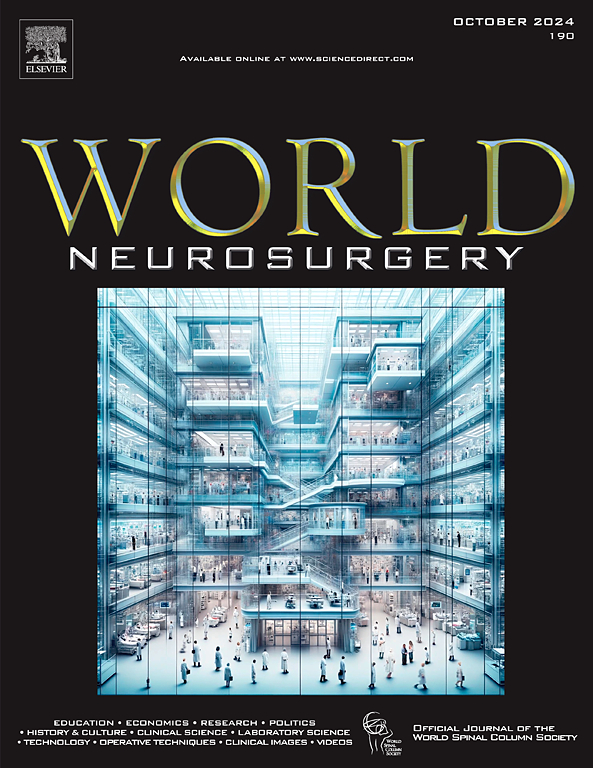IF 1.9
4区 医学
Q3 CLINICAL NEUROLOGY
引用次数: 0
摘要
目的:机器人辅助皮质骨轨迹(CBT)螺钉置入术比传统的透视辅助方法更安全。这是第一份报告机器人辅助 CBT 螺钉植入的新技术的技术说明。技术说明:在腰椎椎间笼定位后,第二步是俯卧位机器人辅助 CBT 螺钉植入。进行正中皮肤切口,确保切口尽可能小。在无菌机器人触摸屏上规划 CBT 螺钉的方向和轨迹。使用导航钻头突破进入点的皮质表面。然后,使用导航钻头完成螺钉轨迹的暴露。螺钉在机器人手臂的支持下植入。在单体位手术中,手术区域必须从第一步手术开始就做好准备。所有导航参照物都放置在同一髂嵴上。接下来的步骤与双位置手术类似:这是首次报道机器人辅助经肌 CBT 螺钉置入用于 LLIF 后固定的技术说明。所提出的手术技术旨在将 CBT 螺钉的优势与创新的机器人辅助技术相结合。本文章由计算机程序翻译,如有差异,请以英文原文为准。
Enabling Technology with Minimally Invasive Strategies: Robot-Assisted Cortical Bone Trajectory Screw Fixation in Lateral Transpsoas Interbody Fusion
Objective
Robot-assisted cortical bone trajectory (CBT) screw placement is safer than the traditional fluoroscopy-assisted approach. This technical note reports a novel technique of robot-assisted CBT screw placement using a subfascial transmuscular approach.
Methods
This technique involves two stages: first, the positioning of a lumbar interbody cage through a lateral transpsoas approach, and then, the robot-assisted placement of CBT screws. The second step is performed with the patient in prone position with navigation frames (ICT, DRB, and surveillance-marker) registered to the robotic system. A three-dimensional fluoroscopic scan is used to plan the screw trajectory, diameter, and length. The screws are placed with the support of a robotic arm.
Results
The technique allows for accurate and precise placement of CBT screws with minimal soft tissue dissection. Compared to traditional methods, the single-lateral position approach reduces intraoperative time and minimizes postoperative pain and recovery time. The percutaneous transmuscular approach avoids the need for fascial dissection, decreasing the risk of complications such as seroma or hematoma formation.
Conclusions
To our knowledge, this is the first reported technical note about robot-assisted transmuscular CBT screw placement for posterior fixation in LLIF. The proposed surgical technique aims to combine the advantages of CBT screws and the use of innovative robot-assisted technology.
求助全文
通过发布文献求助,成功后即可免费获取论文全文。
去求助
来源期刊

World neurosurgery
CLINICAL NEUROLOGY-SURGERY
CiteScore
3.90
自引率
15.00%
发文量
1765
审稿时长
47 days
期刊介绍:
World Neurosurgery has an open access mirror journal World Neurosurgery: X, sharing the same aims and scope, editorial team, submission system and rigorous peer review.
The journal''s mission is to:
-To provide a first-class international forum and a 2-way conduit for dialogue that is relevant to neurosurgeons and providers who care for neurosurgery patients. The categories of the exchanged information include clinical and basic science, as well as global information that provide social, political, educational, economic, cultural or societal insights and knowledge that are of significance and relevance to worldwide neurosurgery patient care.
-To act as a primary intellectual catalyst for the stimulation of creativity, the creation of new knowledge, and the enhancement of quality neurosurgical care worldwide.
-To provide a forum for communication that enriches the lives of all neurosurgeons and their colleagues; and, in so doing, enriches the lives of their patients.
Topics to be addressed in World Neurosurgery include: EDUCATION, ECONOMICS, RESEARCH, POLITICS, HISTORY, CULTURE, CLINICAL SCIENCE, LABORATORY SCIENCE, TECHNOLOGY, OPERATIVE TECHNIQUES, CLINICAL IMAGES, VIDEOS
 求助内容:
求助内容: 应助结果提醒方式:
应助结果提醒方式:


